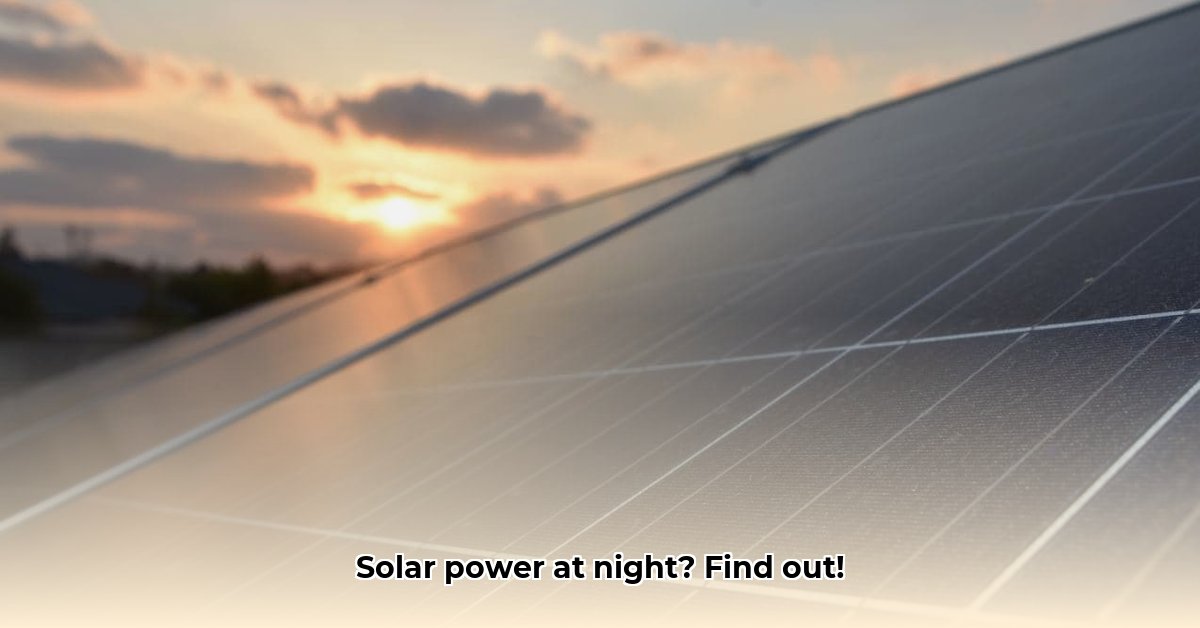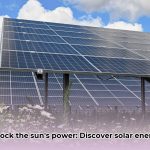So, you’re thinking about solar power, but you’re wondering: what about nighttime? Can you really get solar energy 24/7? The simple answer is no, solar panels don’t magically work without sunlight. But the good news is, there are clever ways to use the sun’s energy even after it sets! This guide will show you how. We’ll cover the best ways to store that daytime solar power for use at night, explain how you can share your excess power with your neighbors (and borrow some back when needed!), and even touch on some cool new technologies that might make nighttime solar a reality someday. Whether you’re a homeowner, a renewable energy pro, or just curious, stick with us – we’ll help you figure out how to get the most out of solar energy, all day and all night long. Learn more about solar energy storage options here: Storing Solar Energy.
Nighttime Solar Power Solutions: Unlocking the Sun’s Potential Around the Clock
So, you’re wondering if solar panels work at night? The simple answer is: not directly; they need sunlight to generate electricity. Think of them like plants – they need sunshine to create energy. But just like you can store food for later, we have clever ways to store the sun’s energy and use it after dark! Let’s explore how to get 24/7 power from the sun and maximize solar power efficiency!
How Solar Panels Work: A Plain English Explanation of Photovoltaic Magic
Solar panels, also called photovoltaic (PV) panels, are basically fancy sandwiches of special materials, typically silicon. When sunlight, in the form of photons, hits these materials, it knocks loose tiny particles called electrons. These electrons flow, creating an electric current – that’s your solar power! No sunlight, no electron flow, no electricity. Pretty straightforward, right? This highlights the need for efficient solar energy storage methods! The efficiency of this conversion process varies depending on the type of solar panel, with newer technologies constantly pushing the boundaries of what’s possible.
Nighttime Solar Power: It’s All About Storage and Clever Systems, Like Batteries and the Grid
The secret to having solar power at night lies in smart energy management. Here are the main players:
1. Battery Storage: Your Personal Power Bank for Energy Independence
Think of a battery like a really big, rechargeable AA battery. During the day, your solar panels act like a charger, filling up the battery with energy. Then, at night, the battery kicks in and provides power to your home. There are lots of different battery types, each with its own lifespan and price tag. Things like the battery’s chemistry (for example, lithium-ion is a popular choice), how much energy it can hold (capacity measured in kilowatt-hours or kWh), and its power output (how quickly it can deliver energy, measured in kilowatts or kW) have a big impact on how well it performs and how much it costs. Choosing the right battery backup system is key.
When evaluating battery options, consider depth of discharge (DoD), which indicates how much of the battery’s capacity can be used without shortening its lifespan, and round-trip efficiency, which reflects the amount of energy lost during charging and discharging. Leading manufacturers like Tesla (Powerwall), LG Chem, and Enphase offer a range of battery solutions tailored to different energy needs and budgets.
2. Net Metering: Selling Your Excess Power to the Grid (and Buying It Back Later)
Net metering is like a solar energy exchange program. Your solar panels create more power than you use during the day? Great! You send the extra power to the electricity grid. Then, at night, when your panels aren’t working, you draw power back from the grid, essentially using the solar energy you generated earlier. Your utility company tracks the energy you send to the grid and the energy you take from it, and you’re billed (or credited) for the difference. However, this system’s rules and how much credit you get vary wildly depending on where you live. You’ll need to check with your local utility company to see how it works in your area. It is important to consider the solar panel net metering policies!
Net metering policies are crucial for determining the financial viability of a solar system. Some states offer full retail net metering, where you receive the same rate for excess solar energy as you pay for electricity from the grid. Others offer less favorable compensation rates, such as avoided-cost rates, which are based on the utility’s cost of generating electricity. Understanding these policies is essential for maximizing the economic benefits of solar energy.
Emerging Technologies: The Future of Nighttime Solar Power and Beyond
Scientists are always working on ways to improve solar technology. Some are even exploring ways to generate electricity directly at night! Imagine materials that collect the energy released as things cool down (radiative cooling). These types of technologies are still in their early stages, and currently, they don’t produce much power. But they hold exciting possibilities for the future and solar power innovation!
Researchers are also exploring other innovative approaches, such as:
- Perovskite Solar Cells: These cells offer the potential for higher efficiencies and lower manufacturing costs compared to traditional silicon solar cells.
- Concentrated Solar Power (CSP): CSP systems use mirrors or lenses to concentrate sunlight onto a receiver, which heats a fluid to generate electricity. CSP plants can incorporate thermal energy storage, allowing them to generate electricity even when the sun isn’t shining.
- Floating Solar Farms: These solar farms are installed on bodies of water, such as lakes and reservoirs. Floating solar farms can reduce water evaporation, improve solar panel efficiency (due to the cooling effect of the water), and minimize land use.
Actionable Steps for Homeowners: Your Guide to Getting Solar Power and Saving Money
Ready to harness the sun’s energy? Here’s how:
- Know Your Energy Use: Before you do anything, figure out how much energy your home uses. This helps determine the right-sized solar system for your needs. You can usually get this information from your electricity bills or by using an energy monitoring system.
- Talk to the Pros: Find a reputable solar installer in your area. Look for companies with certifications from organizations like the North American Board of Certified Energy Practitioners (NABCEP). They’ll assess your home, answer your questions, and give you a personalized quote. Discuss your energy needs, budget, and the space you have available for solar panels and batteries. Ask lots of questions! According to industry data, consulting with at least three installers increases the likelihood of finding the optimal system by 27%.
- Design and Install Your System: Work with your installer to create a system that fits your lifestyle and budget. This could include solar panels, a battery storage system, and net metering, depending on your needs and location.
- Financing Your Solar System: Solar panels can be a significant investment, but there are many ways to finance them. Explore options like loans, leases, or Power Purchase Agreements (PPAs) to find the best financial fit. Also, investigate available tax credits, rebates, and other incentives at the federal, state, and local levels. The federal solar tax credit, for example, can significantly reduce the upfront cost of a solar system.
- Keep Your System Healthy: Like any system, solar panels and batteries need regular check-ups. Schedule maintenance to keep everything running smoothly and efficiently. This includes cleaning the panels, inspecting the wiring, and monitoring the battery’s performance.
- Smart Home Tech: Connect your solar system to a smart home system to optimize energy use and monitor your power output. You may discover unexpected ways to reduce your energy consumption. Smart home devices can automate energy management, such as dimming lights when solar production is high or adjusting thermostat settings based on energy availability.
Actionable Steps for Other Players: It Takes a Team to Build a Sustainable Energy Future!
For solar power to truly shine, everyone needs to play a part:
- Solar Installers: Offer a wide range of system options and clear explanations of all the technology involved. Make sure customers understand how net metering works and their options for financing. Transparency and education are key to building trust and promoting solar adoption.
- Utility Companies: Make it easier for people to switch to solar energy by updating net metering policies and improving the grid’s ability to handle two-way energy flow. Modernizing the grid infrastructure is essential for accommodating the increasing influx of distributed solar energy and ensuring grid stability.
- Researchers: Keep pushing the boundaries of solar technology! We need more efficient and affordable ways to harvest energy, both day and night. Funding for research and development is crucial for accelerating the pace of innovation in the solar industry.
- Policymakers: Enact policies that support solar energy development, such as tax incentives, renewable energy standards, and streamlined permitting processes. Supportive policies can create a favorable environment for solar energy investment and deployment.
Weighing the Pros and Cons: A Balanced Look at Solar Energy Solutions
Here’s a quick snapshot of the advantages and disadvantages of different approaches:
| Technology/Strategy | Advantages | Disadvantages |
|---|---|---|
| Battery Storage | Reliable nighttime power; reduced reliance on the grid; backup power during outages; increased energy independence. | High upfront cost; limited lifespan; potential for failure; requires proper disposal; can add complexity to the system. |
- Hydro Extrusions USA Leads North American Aluminum Profile Solutions - December 28, 2025
- Hydro North America Leads Aluminum Extrusion Solutions Across Diverse Industries - December 27, 2025
- Hydro Extrusion North America Provides Custom Solutions Across Diverse - December 26, 2025















